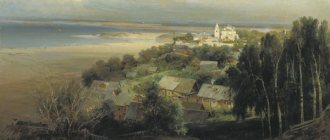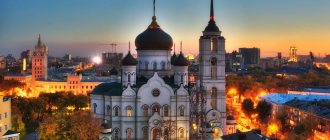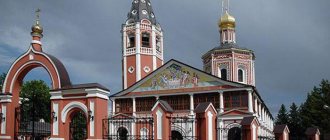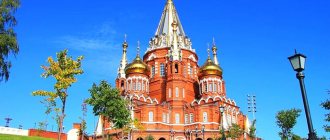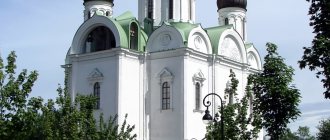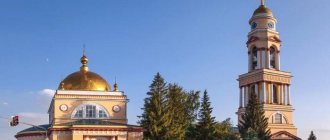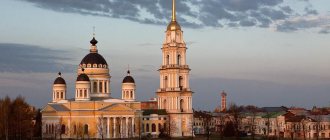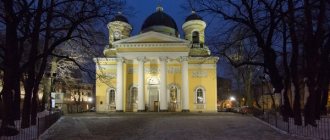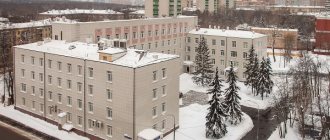Over the past decades in Russia, in addition to the restoration and reconstruction of church buildings that were once taken away from believers and which had fallen into disrepair over the years, a lot of work has been done to build new church buildings. One of the striking examples of this process is the history of St. Nicholas Cathedral in Nizhny Novgorod. The schedule of services held there, an overview of the main activities of the Orthodox cultural and educational center created on its basis, as well as the history of the emergence of the temple complex became the topic of this article.
The first steps of a good endeavor
The history of the community of St. Nicholas Cathedral in Nizhny Novgorod is inextricably linked with the improvement of the spiritual life of the country, which was the result of perestroika and a radical change in government policy towards the church. In 1992, among believers in the Avtozavodsky district of the city, the idea of building a church arose, since during the years of Soviet power all the churches that once existed in the district were destroyed.
The first step towards the implementation of the plan was the registration of the local community, carried out in 1994. Its head then became one of the most active Orthodox activists, Maria Stepanovna Pypina. However, a community is just a community of believers united for the purpose of jointly performing various services and rituals. In order to rise to the next level and become a parish, a temple and its ministers are needed, around whom the members of the previously created community will unite.
The parish in the area was created due to the fact that in 1997 the city authorities placed at the disposal of believers the premises of a kindergarten, which was quickly converted to perform divine services and services there. Somewhat later, a house church was created in the same building, consecrated in honor of St. Seraphim of Sarov.
According to the Novgorod First Chronicle, the cathedral was founded in 1113 by Prince Mstislav Vladimirovich.
St. Nicholas Cathedral is the oldest surviving stone structure on the Trade Side. Dedicated to St. Nicholas of Myra, one of the most revered saints in Rus'.
A legend has been preserved that Saint Nicholas of Myra, who was seriously ill in his thirtieth year, appeared in a dream to Prince Mstislav, ordering him to send an embassy to Kyiv for a round icon of St. Nicholas. Due to a sudden storm, the messengers were only able to reach Lipno Island on Lake Ilmen, where they found an icon with a miraculous image floating on the waves. The revealed icon was taken to Novgorod, and the prince received healing. In honor of his miraculous salvation, Mstislav ordered the foundation of a temple in the name of St. Nicholas on the Trade side of the city, “in the Yaroslavl courtyard.”
The exact date of completion of construction is unknown. It is considered to be the year 1136, in which, according to the First Novgorod Chronicle, the cathedral was consecrated.
It was in St. Nicholas Cathedral that a semicircular, smooth central altar ledge first appeared. Later, this type of projections became traditional for Novgorod architecture of the 12th century. Also traditional for all subsequent Novgorod architecture were the flat blades of the walls adopted from Sofia and the round drums of the domes without semi-columns.
Above the entrance to the temple there were princely quarters (choirs). The cathedral was built as a princely palace church. Initially, one entered this part of the temple through a doorway discovered in the second tier of the western section of the southern wall, which connected the princely quarters with the passage to the palace. The lack of internal communication between the lower and upper floors indicates their deliberate isolation.
The first significant reconstruction of the temple was undertaken already in the middle of the 12th century - in connection with the transformation of the princely palace church into a city cathedral, near the walls of which the veche gathered. The main “democratic” transformation of this period was the stone spiral staircase for climbing to the floor. At the same time, the masonry of the staircase partially covered the painting, preserving it for a long time.
Over its long history, the temple went through a long series of fires and subsequent reconstructions and repairs. In the 18th century, according to Archimandrite Macarius, St. Nicholas Cathedral “almost did not differ from the poorest churches in terms of external and internal structure”: the upper parts of the four small drums, the spiral staircase, the central part of the choir vault, the central part of the narthex wall were dismantled, some were expanded windows, a hipped roof over the main volume and a helmet-shaped head over the central drum. But already the 19th century entered the history of the cathedral with its splendor: new decoration of the chapels, cast-iron floors and a new iconostasis.
No information has been found about the abolition of St. Nicholas Cathedral as an active temple after the October Revolution; According to data from June 1921, the temple was operational. In 1933, the cathedral became accessible to ordinary visitors, combining the functions of a temple and a museum.
During the occupation of Novgorod by the Nazi invaders, the temple was turned into a barracks for soldiers. The iconostasis was dismantled, the local row of the iconostasis was practically lost. In 1945, the monument was transferred to the church, and in 1962 it was returned to the museum. Since 1963, it has housed an exposition of scientific atheism and a planetarium.
Through the efforts of restorers at the end of the last century, the temple was restored to its original forms and is a pearl of Novgorod architecture.
Currently, the permanent exhibition “St. Nicholas Cathedral: Research and Restoration” is presented in the St. Nicholas Cathedral, and temporary museum exhibitions are located. Thanks to modern technologies, you can see what the St. Nicholas iconostasis once was like: a multimedia panorama with a 360-degree screen recreates it in the period before the 80s of the last century: five tiers and more than 40 icons. Another multimedia exhibition will allow you to plunge into the atmosphere of medieval Novgorod and hear the voices of ancient Torg.
The combination of genuine antiquity, modern technology and thematic excursions make this architectural monument extremely interesting for any visitor.
Construction of a wooden church
A year later, when plans were already being made for the foundation of the future St. Nicholas Cathedral (Nizhny Novgorod), the diocesan leadership decided to build a wooden church for the newly created community. It was intended for a more complete organization of the religious life of parishioners during the construction of the main temple.
Such a church was built and consecrated in honor of the holy martyr Tatiana, and all the work, both external and internal, was carried out during Lent, and by the Bright Resurrection of Christ the church was consecrated. In the same year, the city cinema building, which had been under construction during communist rule but was never completed, was handed over to the community, in which a regional Orthodox center was created by the diocese, headed by Abbot Innokenty (Samylkin).
Shrines
Being completely young in terms of time, the cathedral attracts with its miraculous shrines. Pilgrims and parishioners can often be seen in prayer at the arks with particles of the relics of such saints:
- Saint Tikhon;
- Bethlehem Babies;
- blessed Peter and Fevronia;
- Great Martyr Anastasia;
- Reverend Martha and Alexandra of Diveevsky;
- noble prince Peter of Murom;
- Optina elders.
Often parishioners come with their problems to the miraculous holy images of St. Seraphim of Sarov, the Great Martyr Princess Elizabeth, and St. Innocent.
Painting the walls of St. Nicholas Church
The cathedral carved cross is an exact copy of the cross that was given to the residents of Nizhny Novgorod by Prince Dmitry Pozharsky.
On a note! Throne services are held in honor of the patrons of the Cathedral of St. Nicholas the Pleasant on May 22 and December 19, and the martyr Tatiana on January 25.
Start of construction and first difficulties
At the end of the summer of the same year, preparations began for the construction of one of the main churches in Nizhny Novgorod today - St. Nicholas Cathedral. According to a tradition that developed back in ancient times, the first step was the consecration of the place chosen for it with the erection of a worship cross. This ceremony, performed on August 21, became the beginning of a arduous journey for the creators of the future temple.
According to construction participants, difficulties began after a sharp shortage of funds became apparent. The donations made by employees of the Gorky Automobile Plant, as well as city residents who expressed a desire to take part in this pious cause, were only enough to lay bricks at the base of the cathedral, after which construction was frozen.
20th Sunday after Pentecost
October 23 – Memorial Day of St. Ambrose of Optina
Alexander Grenkov, the future father Ambrose, was born on November 21 or 23, 1812, in the spiritual family of the village of Bolshiye Lipovitsy, Tambov Diocese. Having graduated from the Theological School, he then successfully completed a course at the Theological Seminary. However, he did not go to the Theological Academy or become a priest. For some time he was a home teacher in a landowner family, and then a teacher at the Lipetsk Theological School. Possessing a lively and cheerful character, kindness and wit, Alexander Mikhailovich was very loved by his comrades and colleagues. In his last year at the Seminary, he had to suffer a dangerous illness, and he vowed to become a monk if he recovered.
Resumption of work
However, it is well known that from time immemorial in Rus' the main donor for the construction of God's temples was the people, with whose funds most of the shrines were erected. St. Nicholas Cathedral in Nizhny Novgorod was no exception. Thanks to the active actions of Orthodox activists, as well as measures taken by the diocesan leadership, a very significant amount was collected, and in the spring of 2006, work on the construction of the temple resumed. In parallel with this, further fundraising did not stop, carried out both in Nizhny Novgorod itself and in many other cities of the Volga region and Central Russia.
In the architecture of the St. Nicholas Cathedral (address: Nizhny Novgorod, Druzhaeva St., 3a), motifs that are well known from the outlines of the Transfiguration Church and the Diveyevo Monastery, famous throughout the country, are clearly visible. What distinguishes it from this structure are such elements as a high multi-stage porch and a chapel and bell tower separately attached to the main building.
During the work, technologies were used that were tested and proven successful in the construction of such famous buildings as the capital’s Cathedral of Christ the Savior and the Cathedral of St. Theodore Ushakov in Saransk.
Giant Temple
St. Nicholas Cathedral, built in Nizhny Novgorod, has a height of 68.5 meters, which puts it among the tallest temple buildings erected in Russia over the last century. The premises located on the lower level include a refectory that can accommodate up to 100 people, a baptismal area, a conference room, a library, sacristies and a Sunday school.
The main temple premises are located on the upper tier. It can accommodate up to 3 thousand people at a time. Adjacent to it is a spacious three-altar altar. A characteristic feature of the internal structure of the cathedral is the presence of an elevator, with the help of which disabled people are transported to the second floor.
The Cathedral of St. Nicholas is part of the temple complex, one of the constituent parts of which is the St. Nicholas Cultural and Educational Orthodox Center, organized on the basis of the cinema transferred to the church, which was discussed above. Today, within its walls there is a Sunday school, a library, an icon-painting workshop, as well as a singing school, designed for both children and their parents.
Jewish synagogues
Here it is worth noting the religious organization of Orthodox Judaism - the Nizhny Novgorod Jewish Community, which consists of 10 thousand people, and its history goes back a little more than a century and a half. The synagogue occupies a central place in the community. All traditional rituals of Judaism take place within its walls, a mikveh operates, and humanitarian and material assistance to those in need is widely developed.
Address: Nizhny Novgorod district, Gruzinskaya st., 5a. The nearest tram stop is Bolshaya Pokrovskaya, bus stop is Ploshchad Gorky, metro station is Gorkovskaya.
St. Nicholas Cathedral (Nizhny Novgorod): schedule of services
Despite the importance of the cultural and educational center and its teachers, the main burden in the matter of churching the city’s residents falls on the clergy. It is this organization that takes full care of the care of the parishioners of St. Nicholas Cathedral in Nizhny Novgorod. The schedule of services held there fully complies with the annual cycle adopted by the Charter of the Russian Orthodox Church. Both on weekdays and on holidays, the early liturgy begins at 6:30, and the late one at 8:30. Evening services in the cathedral begin at 16:00.
